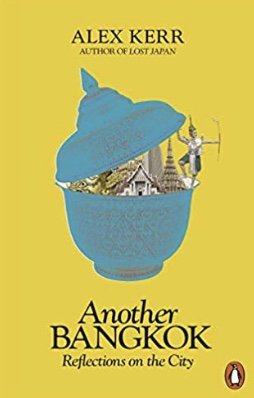Another Bangkok: Reflections on the City by Alex Kerr (Penguin Random House UK)
Alex Kerr made a name for himself as a leading foreign expert on Japan when he won the Shincho Gakugei Literary Prize in 1994 for the best work of nonfiction published that year in Japan. Kerr was the first foreigner to have won this prize with Lost Japan, a book he wrote in Japanese. By that time, Kerr had lived in Japan for seventeen years, the country he had chosen as a home when he was still in his twenties.
Three years later, Kerr established a second home in Bangkok, dividing his time between Thailand and Japan. Within five years of that decision, he published Bangkok Found, a book of essays about his new life and what he discovered there. Twelve years later, he expanded upon that theme with new discoveries and a different focus, one that echoes the theme of Lost Japan, “the past and what it has to teach us.”
Another Bangkok is Kerr’s search for the “wellsprings” of culture that underpin the “chaos and ugliness” of Thailand’s primate city. He finds a wealth of “kaleidoscopically complex cultural traditions” that were originally adopted from India, Cambodia, and China and were transformed into an amalgamation that is completely Thai. Sri Lankan stupas and Angkor’s towers have become slender and elongated in their Thai incarnations. The Buddha rose from his seated position and began to walk gracefully under the hands of Sukkothai sculptors. The ceramics of China were translated into vessels of riotous color when Thai craftsmen began to use Benjarong’s five colors, bright, controlled, and dazzlingly ornate. Even Western skyscrapers have taken on surprising shapes as they dominate the Bangkok skyline, using the traditional Thai features of teak pillars and delicately curved roofs.
Bangkok, Kerr says, was rooted in this sort of adaptivity. The enshrined city pillars are based on the lingam of Angkor. “They’re really Khmer,” a Thai aristocrat told him. The Grand Palace, Thailand’s primary national symbol, is a “treasure house” of elements from different cultures, combined into a glorious extravaganza of “exotic fantasy.”
Kerr finds quite a bit of exotic fantasy in his examination of Thai traditional culture and he writes about it beautifully. His essay on the Grand Palace alone is stunning, giving a whole new view to what has become a visual cliche. But in his following essays, his focus becomes diluted. Traffic jams and tangles of electrical wires invade his examination of Thai floral art and a discursion into sex tourism interrupts his look at classical Thai dance. His own experiences in Bangkok are mentioned in passing, along with some of his memories from Japan, in a way that’s frequently more annoying than it is illuminating. Why, for example, are expats even discussed in a book that purports to be about traditional Thai culture? Not even Kerr seems to know, torn as he is between regarding his own kind as a form of beneficial and creative “yeast” in the city or “a hair in the soup.”
Kerr seems to find comfort in the creation of “a beautiful surface” that’s more important than substantial content, a practice that he finds in Thailand as much as he has in Japan. Another Bangkok slides gracefully over its own beautiful surface, a fusion of memoir and research that’s essentially “charming but trivial,” much more like a series of articles written for a variety of magazines than a thoughtful and coherent book. ~Janet Brown
